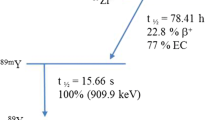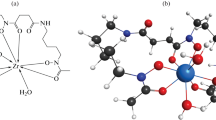Abstract
In recent years, clinical imaging with zirconium-89 (89Zr)-labelled monoclonal antibodies (Ab) by positron emission tomography (immunoPET) has been gaining significant importance in nuclear medicine for the diagnosis of different types of cancer. For complexation of the radiometal 89Zr and its attachment to the Ab, chelating agents are required. To date, only the hexadentate chelator desferrioxamine (DFO) is applied in the clinic for this purpose. However, there is increasing preclinical evidence that the [89Zr]Zr-DFO complex is not sufficiently stable and partly releases the radiometal in vivo due to the incomplete coordination sphere of the metal. This leads to unfavourable unspecific uptake of the osteophilic radiometal in bones, hence decreasing the signal-to-noise-ratio and leading to an increased dose to the patient. In the past, several new chelators with denticities > 6 have been published, notably the octadentate DFO derivative DFO*. DFO*, however, shows limited water solubility, wherefore an oxygen containing analogue, termed oxoDFO*, was developed in 2017. However, no data on the suitability of oxoDFO* for radiolabelling with 89Zr has yet been reported. In this proof-of-concept study, we present the first radiolabelling results of the octadentate, water-soluble chelator oxoDFO*, as well as the in vitro stability of the resulting complex [89Zr]Zr-oxoDFO* in comparison to the analogous octadentate, but less water-soluble derivative DFO* and the current “standard” chelator DFO. In addition, the suitability of DFO* and oxoDFO* for radiolabeling with the short-lived PET metal gallium-68 is discussed.
Graphic abstract
The water-soluble, octadentate chelator oxoDFO* provides stable complexes with the positron emitter Zirconium-89. The radiolabelling can be performed at room temperature and neutral pH and thus, oxoDFO* represents a promising chelator for applications in immunoPET.





Similar content being viewed by others
References
Barbet J, Bardies M, Bourgeois M, Chatal JF, Cherel M, Davodeau F, Faivre-Chauvet A, Gestin JF, Kraeber-Bodere F (2012) Radiolabeled antibodies for cancer imaging and therapy. Methods Mol Biol (Clifton, NJ) 907:681–697
Brandt M, Cardinale J, Aulsebrook ML, Gasser G, Mindt TL (2018) An overview of PET radiochemistry, part 2: radiometals. J Nucl Med 59(10):1500–1506
McInnes LE, Rudd SE, Donnelly PS (2017) Copper, gallium and zirconium positron emission tomography imaging agents: the importance of metal ion speciation. Coord Chem Rev 352:499–516
Bensch F, van der Veen EL, Lub-de Hooge MN, Jorritsma-Smit A, Boellaard R, Kok IC, Oosting SF, Schröder CP, Hiltermann TJN, van der Wekken AJ, Groen HJM, Kwee TC, Elias SG, Gietema JA, Bohorquez SS, de Crespigny A, Williams S-P, Mancao C, Brouwers AH, Fine BM, de Vries EGE (2018) 89Zr-atezolizumab imaging as a non-invasive approach to assess clinical response to PD-L1 blockade in cancer. Nat Med 24(12):1852–1858
Dijkers ECF, Kosterink JGW, Rademaker AP, Perk LR, van Dongen GAMS, Bart J, de Jong JR, de Vries EGE, Lub-de Hooge MN (2009) Development and characterization of clinical-grade 89Zr-Trastuzumab for HER2/neu ImmunoPET imaging. J Nucl Med 50(6):974–981
Yoon JT, Longtine MS, Marquez-Nostra BV, Wahl RL (2018) Evaluation of next-generation anti-CD20 Antibodies Labeled With 89Zr in human lymphoma xenografts. J Nucl Med 59(8):1219–1224
Bahce I, Huisman MC, Verwer EE, Ooijevaar R, Boutkourt F, Vugts DJ, van Dongen GA, Boellaard R, Smit EF (2014) Pilot study of 89Zr-bevacizumab positron emission tomography in patients with advanced non-small cell lung cancer. EJNMMI Res 4(1):35
Ryman JT, Meibohm B (2017) Pharmacokinetics of monoclonal antibodies. CPT Pharmacometrics Syst Pharmacol 6(9):576–588
Carmon KS, Azhdarinia A (2018) Application of immuno-PET in antibody-drug conjugate development. Mol Imaging 17:1536012118801223
van Dongen GA, Visser GW, Lub-de Hooge MN, de Vries EG, Perk LR (2007) Immuno-PET: a navigator in monoclonal antibody development and applications. Oncologist 12(12):1379–1389
Racow EE, Kreinbihl JJ, Cosby AG, Yang Y, Pandey A, Boros E, Johnson CJ (2019) General approach to direct measurement of the hydration state of coordination complexes in the gas phase: variable temperature mass spectrometry. J Am Chem Soc 141(37):14650–14660
Adams CJ, Wilson JJ, Boros E (2017) Multifunctional desferrichrome analogues as versatile 89Zr(IV) chelators for immunoPET probe development. Mol Pharm 14(8):2831–2842
Holland JP, Divilov V, Bander NH, Smith-Jones PM, Larson SM, Lewis JS (2010) 89Zr-DFO-J591 for immunoPET of prostate-specific membrane antigen expression in vivo. J Nucl Med 51(8):1293–1300
Heskamp S, Raavé R, Boerman O, Rijpkema M, Goncalves V, Denat F (2017) 89Zr-immuno-positron emission tomography in oncology: state-of-the-Art 89Zr radiochemistry. Bioconjug Chem 28(9):2211–2223
Guérard F, Beyler M, Lee YS, Tripier R, Gestin JF, Brechbiel MW (2017) Investigation of the complexation of natZr(iv) and 89Zr(iv) by hydroxypyridinones for the development of chelators for PET imaging applications. Dalton Trans 46(14):4749–4758
Tieu W, Lifa T, Katsifis A, Codd R (2017) Octadentate zirconium(IV)-loaded macrocycles with varied stoichiometry assembled from hydroxamic acid monomers using metal-templated synthesis. Inorg Chem 56(6):3719–3728
Patra M, Bauman A, Mari C, Fischer CA, Blacque O, Haussinger D, Gasser G, Mindt TL (2014) An octadentate bifunctional chelating agent for the development of stable zirconium-89 based molecular imaging probes. Chem Commun 50(78):11523–11525
Vugts DJ, Klaver C, Sewing C, Poot AJ, Adamzek K, Huegli S, Mari C, Visser GW, Valverde IE, Gasser G, Mindt TL, van Dongen GA (2017) Comparison of the octadentate bifunctional chelator DFO*-pPhe-NCS and the clinically used hexadentate bifunctional chelator DFO-pPhe-NCS for 89Zr-immuno-PET. Eur J Nucl Med Mol Imaging 44(2):286–295
Rudd SE, Roselt P, Cullinane C, Hicks RJ, Donnelly PS (2016) A desferrioxamine B squaramide ester for the incorporation of zirconium-89 into antibodies. Chem Commun 52(80):11889–11892
Berg E, Gill H, Marik J, Ogasawara A, Williams SP, van Dongen G, Vugts DJ, Cherry SR, Tarantal AF (2019) Total-body PET and highly stable chelators together enable meaningful (89)Zr-antibody-PET studies up to 30 days post-injection. J Nucl Med. https://doi.org/10.2967/jnumed.119.230961
Batista ANL, Batista JM Jr, Bolzani VS, Furlan M, Blanch EW (2013) Selective DMSO-induced conformational changes in proteins from Raman optical activity. Phys Chem Chem Phys 15(46):20147–20152
Melnikova YI, Odintsov SG, Kravchuk ZI, Martsev SP (2000) Antigen-binding activity of monoclonal antibodies after incubation with organic solvents. Biochem Biokhim 65(11):1256–1265
Richardson-Sanchez T, Tieu W, Gotsbacher MP, Telfer TJ, Codd R (2017) Exploiting the biosynthetic machinery of Streptomyces pilosus to engineer a water-soluble zirconium(iv) chelator. Org Biomol Chem 15(27):5719–5730
Brown CJM, Gotsbacher MP, Codd R (2020) Improved access to linear tetrameric hydroxamic acids with potential as radiochemical ligands for zirconium-89 PET imaging. J Austr J Chem. https://doi.org/10.1071/CH19518
Briand M, Aulsebrook ML, Mindt TL, Gasser G (2017) A solid phase-assisted approach for the facile synthesis of a highly water-soluble zirconium-89 chelator for radiopharmaceutical development. Dalton Trans 46(47):16387–16389
Holland JP (2020) Predicting the thermodynamic stability of zirconium radiotracers. Inorg Chem 59(3):2070–2082
Vanasschen C, Brandt M, Ermert J, Coenen HH (2016) Radiolabelling with isotopic mixtures of 52 g/55Mn(II) as a straight route to stable manganese complexes for bimodal PET/MR imaging. Dalton Trans (Cambrid, Engl) 45(4):1315–1321
Deri MA, Ponnala S, Zeglis BM, Pohl G, Dannenberg JJ, Lewis JS, Francesconi LC (2014) Alternative chelator for (8)(9)Zr radiopharmaceuticals: radiolabeling and evaluation of 3,4,3-(LI-1,2-HOPO). J Med Chem 57(11):4849–4860
Zeglis BM, Lewis JS (2011) A practical guide to the construction of radiometallated bioconjugates for positron emission tomography. Dalton Trans 40(23):6168–6195. https://doi.org/10.1039/C0DT01595D
Patra M, Bauman A, Fischer C, Mari C, Gasser G, Mindt T (2014) DFO*: a novel octadentate BFCA for zirconium-89. Nucl Med Biol 41(7):634
Bartal AH, Lavie E, Boazi M, Weininger J, Bitton M, Iosilevsky G, Front D, Hirshaut Y, Robinson E (1987) Human sarcoma-associated murine monoclonal antibody labeled with indium-111, gallium-67, and iodine-125. NCI Monogr Publ Natl Cancer Inst 3:153–155
Koizumi M, Endo K, Kunimatsu M, Sakahara H, Nakashima T, Kawamura Y, Watanabe Y, Saga T, Konishi J, Yamamuro T, Hosoi S, Toyama S, Arano Y, Yokoyama A (1988) 67 Ga-labeled antibodies for immunoscintigraphy and evaluation of tumor targeting of drug-antibody conjugates in mice. Cancer Res 48(5):1189–1194
Motta-Hennessy C, Eccles SA, Dean C, Coghlan G (1985) Preparation of 67Ga-labelled human IgG and its Fab fragments using desferoxamine as chelating agent. Eur J Nucl Med 11(6):240–245
Oroujeni M, Garousi J, Andersson KG, Lofblom J, Mitran B, Orlova A, Tolmachev V (2018) Preclinical evaluation of [(68)Ga]Ga-DFO-ZEGFR:2377: a promising affibody-based probe for noninvasive PET imaging of EGFR expression in tumors. Cells 7(9):141
Kaeppeli SAM, Schibli R, Mindt TL, Behe M (2019) Comparison of desferrioxamine and NODAGA for the gallium-68 labeling of exendin-4. EJNMMI Radiopharm Chem 4:9. https://doi.org/10.1186/s41181-019-0060-9
Bauman A, Valverde IE, Fischer CA, Vomstein S, Mindt TL (2015) Development of 68 Ga- and 89Zr-labeled exendin-4 as potential radiotracers for the imaging of insulinomas by PET. J Nucl Med 56(10):1569–1574
Petrik M, Vlckova A, Novy Z, Urbanek L, Haas H, Decristoforo C (2015) Selected 68 Ga-siderophores versus 68 Ga-colloid and 68 Ga-citrate: biodistribution and small animal imaging in mice. Biomed Pap Med Fac Univ Palacky Olomouc Czech 159(1):60–66
Petrik M, Haas H, Schrettl M, Helbok A, Blatzer M, Decristoforo C (2012) In vitro and in vivo evaluation of selected 68 Ga-siderophores for infection imaging. Nucl Med Biol 39(3):361–369
Bauwens M, Chekol R, Vanbilloen H, Bormans G, Verbruggen A (2010) Optimal buffer choice of the radiosynthesis of (68)Ga-Dotatoc for clinical application. Nucl Med Commun 31(8):753–758
Tsionou MI, Knapp CE, Foley CA, Munteanu CR, Cakebread A, Imberti C, Eykyn TR, Young JD, Paterson BM, Blower PJ, Ma MT (2017) Comparison of macrocyclic and acyclic chelators for gallium-68 radiolabelling. RSC Adv 7(78):49586–49599
Acknowledgements
This work was funded by the Swiss National Science Foundation (Grant no. SNSF 205321_157216 to G.G. and T.L.M). The authors thank Katarina Benčurová (Ludwig Boltzmann Institute Applied Diagnostics) and Jonas Aronow (Medical University of Vienna) for technical assistance.
Author information
Authors and Affiliations
Corresponding authors
Ethics declarations
Conflict of interest
Thomas Mindt and Gilles Gasser are co-inventors on pending patent applications describing DFO* and its derivatives. These patent applications are owned by the University of Zurich and the University of Basel. The patent owners have granted an exclusive license to the company ABX Advanced Biochemicals Compounds. The inventors are unrelated to this company.
Additional information
Publisher's Note
Springer Nature remains neutral with regard to jurisdictional claims in published maps and institutional affiliations.
Electronic supplementary material
Below is the link to the electronic supplementary material.
Rights and permissions
About this article
Cite this article
Brandt, M., Cowell, J., Aulsebrook, M.L. et al. Radiolabelling of the octadentate chelators DFO* and oxoDFO* with zirconium-89 and gallium-68. J Biol Inorg Chem 25, 789–796 (2020). https://doi.org/10.1007/s00775-020-01800-4
Received:
Accepted:
Published:
Issue Date:
DOI: https://doi.org/10.1007/s00775-020-01800-4




